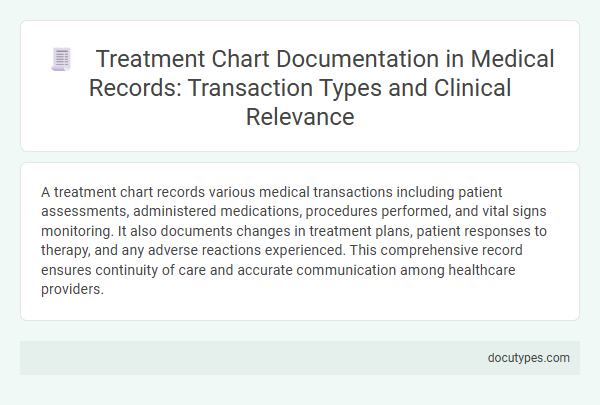A treatment chart records various medical transactions including patient assessments, administered medications, procedures performed, and vital signs monitoring. It also documents changes in treatment plans, patient responses to therapy, and any adverse reactions experienced. This comprehensive record ensures continuity of care and accurate communication among healthcare providers.
Introduction to Treatment Chart Documentation
Treatment chart documentation is essential in medical practice for maintaining accurate records of patient care. It includes transactions such as medication administration, treatment procedures, and patient progress notes. Proper recording ensures effective communication among healthcare providers and supports legal and clinical accountability.
Importance of Accurate Medical Recordkeeping
Treatment charts record various types of transactions, including patient visits, administered medications, diagnostic test results, and treatment plans. Accurate documentation ensures a clear, chronological history of patient care.
Accurate medical recordkeeping is crucial for effective communication between healthcare providers, reducing the risk of errors and improving patient outcomes. Your treatment chart serves as a legal document and supports continuity of care by maintaining precise and detailed information. This comprehensive approach enhances decision-making and safeguards patient safety throughout the treatment process.
Types of Transactions in Medical Records
| Type of Transaction | Description |
|---|---|
| Patient Admissions | Records of initial patient intake, including demographic information, reason for visit, and initial assessments. |
| Clinical Notes | Detailed documents from healthcare providers outlining diagnosis, treatment plans, progress, and patient responses. |
| Medication Administration | Logs of prescribed drugs, dosages, administration times, and any changes in medication throughout treatment. |
| Laboratory and Test Results | Records of diagnostic tests such as blood work, imaging studies, biopsies, with date and interpretation. |
| Procedures and Surgeries | Documentation of all medical procedures performed, including type, date, provider, and outcome notes. |
| Billing Transactions | Entries related to services charged, payments made, insurance claims, and adjustments linked to your treatment. |
| Follow-up and Referral Entries | Notes on follow-up visits, referrals to specialists, and coordination of care across providers. |
Admission and Discharge Documentation
Treatment charts in medical settings meticulously document patient transactions, focusing heavily on admission and discharge records. These records are essential for tracking the patient's medical journey from hospital entry to exit.
- Admission Documentation - Includes patient identification, initial diagnosis, and vital signs recorded at the time of hospital entry.
- Discharge Documentation - Details final diagnosis, treatment summary, medications prescribed, and follow-up care instructions.
- Transaction Chronology - Tracks the timeline of care events, ensuring continuity and legal compliance in patient treatment.
Procedure and Intervention Entries
What types of procedure and intervention entries are recorded in a treatment chart? Procedure entries document specific medical actions performed, such as surgeries, diagnostic tests, or therapeutic techniques. Intervention entries capture the details of treatments administered, including medication dosages, physical therapy sessions, and emergency care measures.
Medication Administration Records
Medication Administration Records (MAR) are a crucial part of treatment charts, documenting every instance of medication given to a patient. These records include details such as medication name, dosage, time of administration, and the healthcare professional responsible. You rely on accurate MAR entries to ensure safe and effective medication management throughout your treatment.
Progress Notes and Clinical Updates
Treatment charts primarily record progress notes and clinical updates, which document a patient's ongoing condition and response to therapy. These entries provide detailed information about symptoms, interventions, and changes observed during each visit.
Progress notes include observations made by healthcare professionals, such as vital signs, medication adjustments, and treatment effectiveness. Clinical updates capture new diagnoses, lab results, and any modifications to the care plan, ensuring continuity and accuracy in patient management.
Error Correction and Amendment Protocols
Treatment charts record various transactions, including medication administration, dosage adjustments, patient vital signs, and procedural notes. Accurate documentation ensures continuity of care and supports clinical decision-making.
Error correction protocols in treatment charts require clear identification of the mistake without obliterating the original entry. Amendments must be dated, signed, and explained to maintain legal and medical integrity.
Legal and Compliance Considerations
Treatment charts document various medical transactions essential for patient care and legal compliance. Accurate record-keeping in these charts supports both clinical decisions and regulatory requirements.
- Patient Consent Records - Signed consents for treatments are recorded to ensure informed patient agreement and legal protection.
- Medication Administration - Details of all prescribed and administered medications are logged to comply with safety and pharmaceutical regulations.
- Treatment Procedures - Each performed procedure is documented to provide a clear medical history and meet professional standards.
Maintaining comprehensive treatment charts is crucial for legal accountability and safeguarding patient rights.
What Types of Transactions Are Recorded in a Treatment Chart? Infographic

